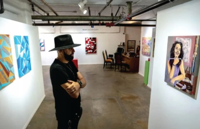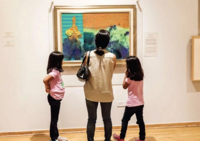
This report was released publicly during a presentation in May 2025 at AAM's Annual Meeting in Los Angeles.
A new report from Latinos LEAD reveals Latinos make up just 7% of museum board members in California, despite being nearly 40% of the state’s population, exposing a major gap in cultural leadership.
The “Leadership & Relevance: California Museums at the Crossroads” report highlights Latino board representation at California museums affiliated with the American Alliance of Museums (AAM), revealing that despite their longstanding financial support, Latinos remain largely absent from museum leadership.
Latinos LEAD believes that nonprofit organizations pursue their missions more effectively when they are governed by boards that reflect core constituent segments. “Our research team thought it might be bad, but we had no idea that nearly half the museums would have no Latinos—we were saddened and surprised. Latinos make up a third of Californians and will be the state’s majority by 2040. Arts organizations are facing an unprecedented existential threat, yet lack authentic connection to the state’s largest single demographic market,” said Patrick Salazar, Latinos LEAD founder and executive director.
Out of the 208 California AAM institutions that were reviewed by the organization, only 7% of board members were Latino and only 6% of them serve at fully accredited AAM institutions. Additionally, there was no Latino representation on nearly half of the museum boardrooms reviewed, such as The Museum of Tolerance, L.A. County Museum of Art, Orange County Museum of Art, and California Academy of Sciences, among many others, while 29% of the other boardrooms only had one Latino member.
California’s population has become increasingly diverse in the last few years and it’s only going to expand gradually. As of now, the majority of the state's population is 40% Latino and more than half of them are young Californian Latino residents.
According to a study released by the UCLA Center for the Study of Latino Health and Culture (CESLAC), it is projected that by 2030, California will be home to 14.8 million Latinos, making them 42% of the state’s population.
It is also known that Los Angeles is home to the largest Latino population, with more than 4.8 million residents living here, which is why it is more important than ever that museums support their local demographics, as the public subsidies will increasingly be paid by the majority of California's Latino new voters by 2050.

The state's 16 million Latinos make up 40% of its residents; by 2040, the state and its workforce will be majority Latino.
Currently there are several barriers that hinder the recruitment of Latino museum board members. According to the Latinos LEAD report, one of the reasons that Latinos are closed out from leadership roles is that several AAM institutions perceive the value of the board as primarily financial, which focuses on only one concept of wealth.
Another reason for the lack of recruitment is the fear of diversifying the board, as it might change the organization overall. The report also stated that “other museums desire to increase their board member diversity, equity and inclusion but cannot find people of color to recruit to their boards.”
Additionally, there are stereotypes about Latinos being "underprivileged," "at-risk" or "disadvantaged" that can generate doubt about whether Latinos can meet annual gift expectations. And also the assumption that Latino board members would take an "activist" stance, upsetting the board's dynamic.
Another challenge Latinos encounter in attaining leadership positions is the reliance on traditional hiring methods that may unintentionally overlook diverse candidates. According to the “AAM/BoardSource in 2021's Leading With Intent,” the top two methods for identifying potential new board members are board members' personal or professional networks (96%) and CEO/ED's personal or professional networks (88%).

Latinos make up fewer than 7% of board members at the 208 California AAM institutions.
Based on the findings of this report, having a more diverse mix of experiences and backgrounds on board teams can contribute to operational outcomes and foster genuine connection to the Latino community, especially since many nonprofit organizations are already serving a significant proportion of the population.















(0) comments
Welcome to the discussion.
Log In
Keep it Clean. Please avoid obscene, vulgar, lewd, racist or sexually-oriented language.
PLEASE TURN OFF YOUR CAPS LOCK.
Don't Threaten. Threats of harming another person will not be tolerated.
Be Truthful. Don't knowingly lie about anyone or anything.
Be Nice. No racism, sexism or any sort of -ism that is degrading to another person.
Be Proactive. Use the 'Report' link on each comment to let us know of abusive posts.
Share with Us. We'd love to hear eyewitness accounts, the history behind an article.